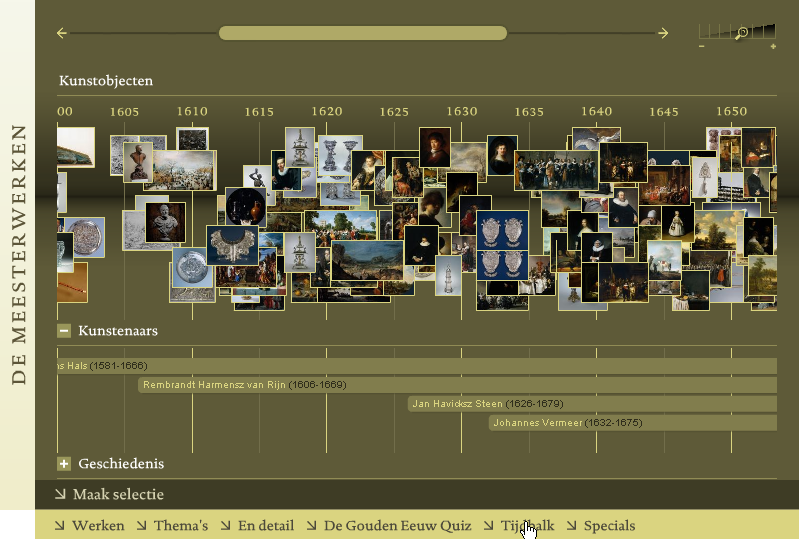Historical Timeline for the Rijksmuseum Amsterdam

The historical timeline for the website of Rijksmuseum Amsterdam was my first large Flash project. At that time I was working for Design Studio Fabrique where I graduated on this project for my study Interaction Design in The Hague in 2004.
Rijksmuseum wanted to present the information about the art-historical objects from their collection on their website in several different online presentations. It was important to make the relations between time, art-works, periods in time, historical events and artists visible for the users of the website in a very interactive way.
One of the presentations Fabrique suggested was a timeline. The Timeline should be very interactive and dynamic. Interactive for the users, dynamic for the editors at the museum so they could easily create new compositions of related information. Rijksmuseum was enthusiastic and the Timeline became my graduation project.
The timeline covers a period of time and shows pictures of art-works. These art-works are in direct relation with the important artists of that time as well with the historical periods and events. The relationship becomes even clearer when the user makes a data selection. The user can for example choose only the paintings to be visible or only the works of a certain artist. Furthermore the hall were an art-work is being exposed or the subject being painted can serve as selection criteria.
One of the most important functionalities of the time is the possibility to zoom in on a certain period. The editors of the museum can choose which level of detail is available for the users. The zoom level with the least detail is the one when all art-work and periods are visible in one overview. On the most detailed level only a very small period of time is visible. At this level you get a precise view of which art-work has been made in which year, which artists were active and which historical events happened.
A detailed description is available of each art-work. Clicking on an object will show an enlargement of the picture with the description and extra details. The timeline was developed while Flash MX 2004 just became available. Flash MX 2004 closed the gap between designers and developers. Flash had finally grown up and could now be used to create serious web applications.
The timeline consists of a set of interface components working closely together, but are separated according to the Model View Controller principle. The art-historic data is being retrieved from an enormous XML database. A thematic selection of this data is made by the editors and stored in the server’s cache. Users can apply filters to narrow the selection.
Technical challenges of this project were to create instantly a large amount of visual objects and to distribute these objects evenly over the screen. To let the timeline work smoothly it was necessary to use well considered structured and indexed data within Flash. Another challenge was the communication between the several interactive presentations. It had to be possible to switch easily between these presentations making use of the same data and filters. The hundreds of pictures the timeline uses are scaled by an advanced image server which takes care of all the pictures used on the Rijksmuseum website.
The website of the Rijksmuseum, with the timeline as an eye-catcher, has been awarded several times. Soon after the launch of the new website, Rijksmuseum won two German awards, an iF Award and a Red Dot Award. It also won an American ADC Award and was nominated at Europrix and SAM Awards. The website has also been added to the Dutch Design Selection 2005.